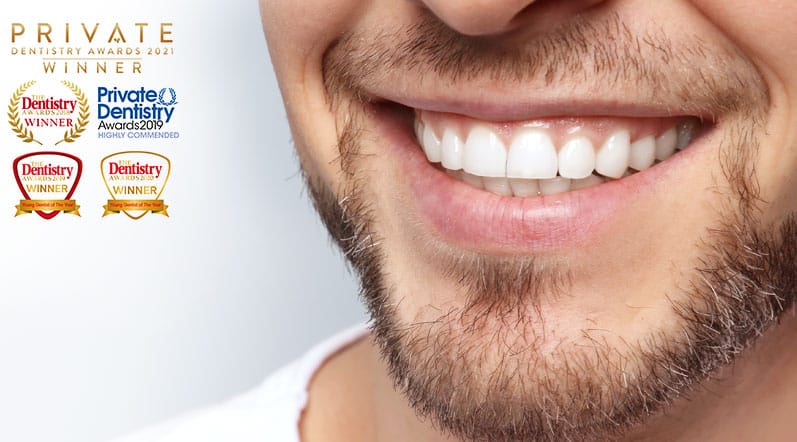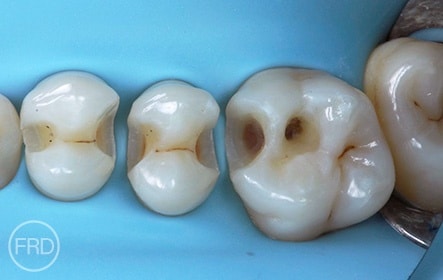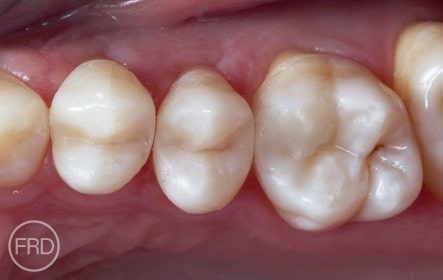Enquire about Restorative Dentistry

What is restorative dentistry?
Restorative dentistry focuses on repairing and improving the function, structure, and appearance of teeth. It aims to restore oral health by addressing issues that affect chewing, speaking, and aesthetics. This particular area of dentistry seeks to preserve natural teeth wherever possible. Through various techniques, restorative dentistry helps maintain overall dental integrity and long-term wellness. It plays a crucial role in ensuring a healthy, functional smile while promoting oral hygiene and overall well-being.
When might restorative treatment be considered?
Restorative dentistry can be beneficial for a variety of reasons. Here are some common situations where restorative treatment might be considered the best option.
Damage to teeth
Teeth can become chipped, cracked, or broken due to accidents, biting hard objects, or general wear and tear. Such damage can weaken the tooth structure, affect appearance, and cause discomfort if not treated promptly.
Tooth wear
Over time, teeth can wear down due to habits like grinding (bruxism), excessive brushing, or exposure to acidic foods and drinks. This can lead to sensitivity, a change in bite alignment, and an increased risk of further damage.
Missing teeth
Tooth loss can occur due to injury, decay, or other dental conditions. Gaps in the smile may cause difficulties with chewing and speaking, while also affecting the alignment of remaining teeth over time.
Decay or structural weakness
Teeth weakened by decay or other factors may become brittle or prone to breaking. Restoring their strength can help prevent further deterioration and maintain long-term oral health.
Bite or alignment issues
Issues with how teeth fit together, such as an uneven bite, can cause strain on the jaw and lead to discomfort or difficulty chewing. Restorative treatment may help correct these imbalances to improve function and comfort.
Aesthetic concerns
Beyond function, the appearance of teeth can impact confidence and self-esteem. Discolouration, uneven shapes, or irregularities in size may lead individuals to seek restorative options for a more uniform, natural-looking smile.

Types of Restorative Dentistry
Restorative dentistry includes various treatments designed to repair, strengthen, or replace teeth, ensuring proper function and aesthetics. The type of treatment required depends on the severity of the damage or tooth loss.
Fillings
Used to restore teeth affected by decay or minor damage, fillings help reinforce the tooth structure. They can be made from materials like composite resin, amalgam, or porcelain.
Crowns
Crowns are custom-made caps that cover and protect damaged or weakened teeth, restoring their strength, shape, and appearance. They are often used after large fillings or root canal treatment.
Inlays and Onlays
Inlays and onlays are custom-made restorations used to repair teeth with moderate decay or damage that is too extensive for a filling but not severe enough to require a crown.
- Inlays fit within the grooves of a tooth’s chewing surface, reinforcing the structure without covering the entire tooth.
- Onlays extend over one or more cusps of the tooth, providing additional coverage and protection.
Made from durable materials such as porcelain, ceramic, or composite resin, inlays and onlays restore strength, function, and aesthetics while preserving as much of the natural tooth as possible. These restorations are designed to blend seamlessly with surrounding teeth for a long-lasting, natural-looking result.
Bridges
A bridge is a fixed restoration that replaces one or more missing teeth by anchoring artificial teeth to adjacent natural teeth or implants.
Dentures
Dentures are removable prosthetic teeth used to replace multiple missing teeth, improving function and appearance.
Dental implants
Dental implants are permanent replacements for missing teeth, consisting of a titanium post surgically placed in the jawbone, topped with a crown for a natural look.
How to find a restorative dentist on Fulham Road, London
Choosing a reputable dentist is one of the best ways to ensure effective, long-lasting results. To find a restorative dentist, start by researching online. Read patient reviews and check clinic websites see their available treatments and credentials.
Recommendations from family, friends, or your general dentist can also be helpful. Look for a specialist with experience in restorative procedures and ensure they use modern techniques and materials.
Finally, consider how much your treatment is going to cost. If you cannot pay for private dentistry costs upfront, some practices offer financing or payment plans to help you spread the cost and manage your budget.
Fulham Road Dental’s restorative dentistry services
With our expert team we offer comprehensive restorative dentistry services at Fulham Road Dental to help preserve and enhance tooth structure.
Our treatments focus on restoring functionality and aesthetics using advanced techniques and materials.
We can provide composite restorations to repair damage caused by decay, wear, or injury, achieving natural-looking results.
For more extensive damage, ceramic (porcelain) restorations such as crowns, inlays, onlays, and overlays are used to protect the tooth structure. We use the very latest digital scanning technology to ensure comfort and precision during these procedures, as well as effective, long-lasting results.

Before Tooth Restoration

After Tooth Restoration
Tooth Restoration FAQs
Can restorative dentistry improve the appearance of my smile?
Yes, restorative dentistry can significantly improve the appearance of your smile. Treatments like crowns, veneers, and fillings can repair damaged or decayed teeth, enhancing both function and aesthetics. These procedures can address issues such as discolouration, chips, cracks, and gaps, creating a more uniform and natural-looking smile.
Additionally, dental implants and bridges can replace missing teeth, restoring the overall appearance of your smile while maintaining facial structure. Each treatment is customised to suit individual needs, helping you achieve the smile you desire.
How long does it take to complete restorative dental treatments?
The time required to complete restorative dental treatments depends on the complexity of the procedure. Simple treatments, like fillings, can be done in a single visit, while more extensive procedures, such as crowns or implants, may take multiple appointments.
For example, placing a dental crown typically involves two visits – one for preparation and one for fitting. More complex restorative work, like full-mouth rehabilitation, may take several weeks to complete. Your dentist will provide an estimated timeline based on your specific needs and treatment plan.
Are restorative treatments covered by insurance?
Restorative treatments may be covered by insurance, though the extent of coverage depends on your provider and plan. Basic procedures such as fillings or crowns are often covered, but more advanced treatments like implants or full mouth restorations might incur additional costs (or not even be covered at all).
It’s essential to check with your insurance provider to understand the details of your coverage, and pre-authorisation may be required for certain treatments. Your dentist can help you verify what is covered and discuss payment options available.
Is restorative dentistry painful?
Restorative dentistry treatments are generally not painful, Modern techniques, including anaesthesia are used to ensure patient comfort. Before starting most procedures, your dentist will apply a local anaesthetic to numb the area, minimising any discomfort. After treatment, some mild soreness or sensitivity may occur, but this typically disappears within a few days.
For more complex procedures, your dentist will discuss pain management options and provide aftercare instructions to help with recovery. Overall, the goal is to make the process as comfortable as possible.
What is the difference between restorative and cosmetic dentistry?
Restorative dentistry focuses on restoring the function and health of damaged or decayed teeth, often improving their appearance in the process. It addresses issues such as cavities, missing teeth, or structural damage. Cosmetic dentistry, on the other hand, primarily aims to enhance the aesthetic appearance of the teeth and smile.
While both fields overlap in some treatments, cosmetic dentistry is more concerned with aesthetics, such as teeth whitening or veneers, rather than restoring tooth function. Restorative care prioritises health, whereas cosmetic dentistry focuses on visual appeal.
Can restorative dentistry prevent further dental issues?
Yes, restorative dentistry can help prevent further dental issues by addressing existing problems before they worsen. Treatments like fillings, crowns, and root canals restore the function and strength of damaged teeth. This in turn helps reduce the risk of decay, infection, or tooth loss.
By repairing damaged or weakened teeth, restorative care also helps maintain proper alignment and bite, which can prevent additional strain or discomfort. Early intervention through restorative dentistry plays a key role in preserving long-term oral health.
Is restorative dentistry suitable for people with sensitive teeth?
Yes, restorative dentistry is suitable for people with sensitive teeth. Dentists can use materials and techniques designed to minimise discomfort, ensuring treatments are comfortable. For instance, fillings and crowns can protect exposed tooth surfaces, helping to reduce sensitivity.
If you experience discomfort during treatments, your dentist can discuss options for pain management or anaesthesia to ensure the procedure is as comfortable as possible. Restorative care can also address underlying issues causing sensitivity, such as cavities or enamel erosion.
Are there non-invasive restorative dentistry options?
Yes, there are non-invasive restorative dentistry options available. These include treatments like cosmetic bonding and dental sealants, which can restore the appearance and function of teeth without the need for drilling or significant alteration.
These options are ideal for minor repairs, such as filling small cavities or fixing chips, and are generally less time-consuming and more comfortable. Non-invasive options are often suitable for patients looking to address cosmetic issues or prevent further damage to the teeth.
Will my teeth function the same after restorative treatments?
After restorative treatments, your teeth should function similarly to how they did before the issue occurred, if not slightly better! Crowns, fillings, and other restorations are designed to restore strength, structure, and functionality to damaged teeth, enabling normal biting and chewing.
While some adjustments may be necessary in certain cases, most patients experience a return to full functionality once the treatment is complete. Your dentist will ensure that the restoration fits comfortably and does not interfere with your bite or daily activities.
How can I maintain the results of restorative dentistry?
To maintain the results of restorative dentistry, it’s important to practice good oral hygiene. This includes regular brushing, flossing, and visits to your dentist for check-ups, as well as avoiding habits that may compromise restorations, such as teeth grinding or chewing hard objects. Following your dentist’s aftercare instructions, especially after procedures like crowns or implants, will help prevent complications.
Additionally, maintaining a balanced diet and staying hydrated can support the longevity of your dental work. Regular professional cleanings can also help protect restorations from plaque build-up or staining.